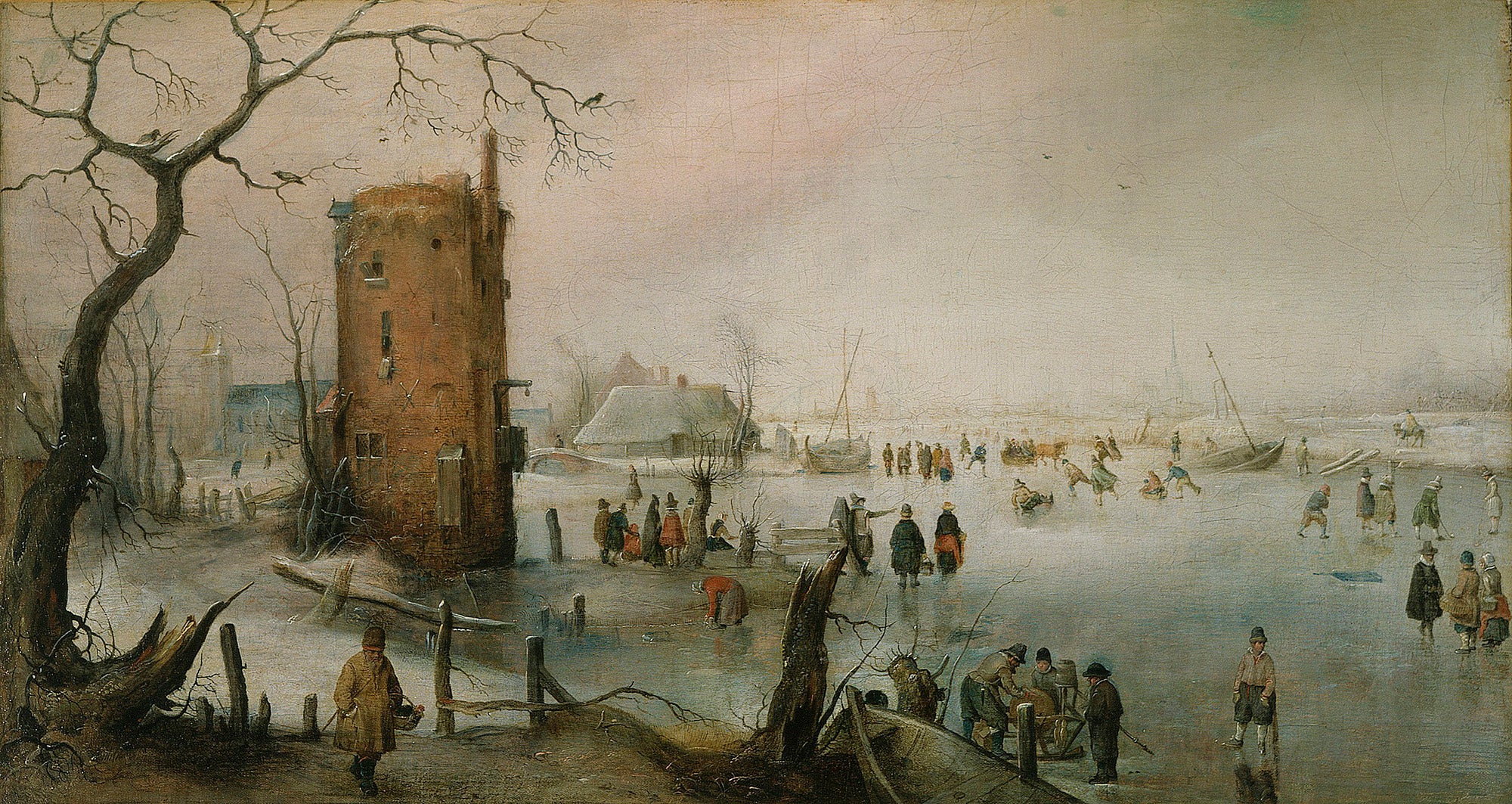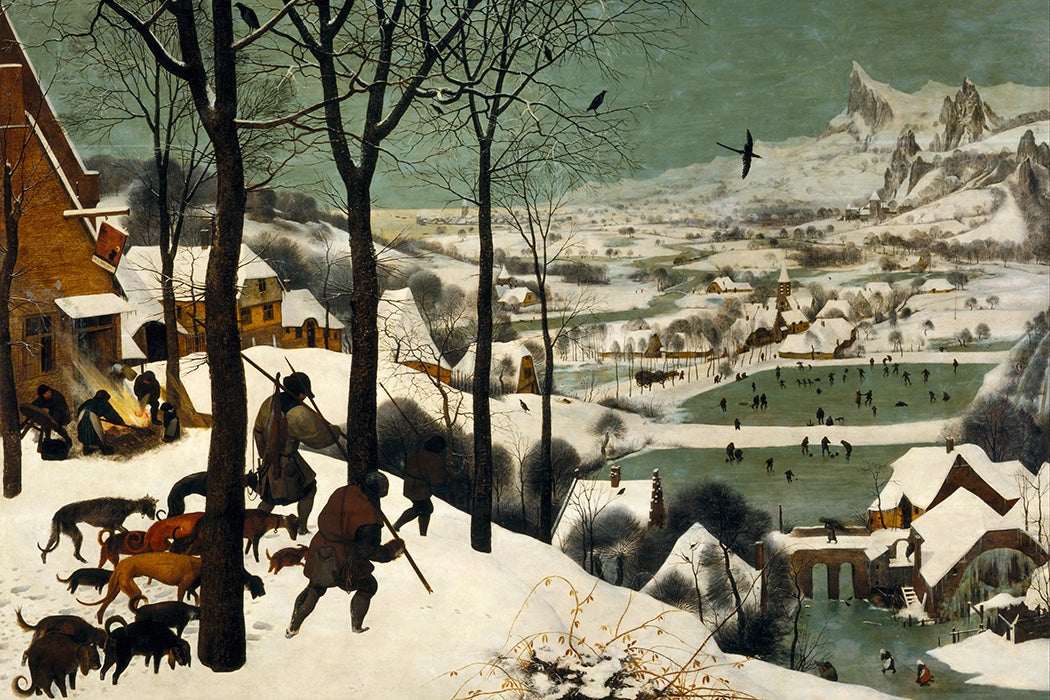When British colonists arrived in New England in the early seventeenth century, they were welcomed by an increasingly extreme and unpredictable climate. August 1635 saw a hurricane so powerful that signs of its destructiveness would, according to William Bradford, the Governor of Plymouth Colony, remain visible for the next one hundred years. The summer of 1637 was so hot several people died, and John Winthrop, the Governor of Massachusetts Bay resorted to traveling at nighttime. The following spring, by contrast, was so cold that harvests failed. Worst of all was the winter of 1641-1642; in his journal, Winthrop noted that “the frost was so great and continual this winter that all the Bay was frozen over, so much and so long, as the like, by the Indians’ relation, had not been so these forty years…”
Nowadays these meteorological anomalies are often cited as manifestations of the so-called Little Ice Age or LIA, a period of slight yet significant global cooling that lasted from circa 1300 to 1850. Researchers say a sudden spike in volcanic eruptions, combined with a prolonged reduction in solar activity, caused temperatures to drop by as much as 3.6 degrees Fahrenheit. Auroras became rare, coronas disappeared from memory, and reports of “dust veils” hovering over the Northern Hemisphere describe the sun as looking a pale red.
Consequences of the LIA were felt across the globe, from South America to East Asia. However, Northern Europe appears to have been particularly affected. Scandinavia, already one of the coldest places on Earth, experienced one of its coldest winters in 1641-1642. Between 1640 and 1644, creeping glaciers swallowed up entire farmsteads in the Alps. By August, “there was such a great cold we almost froze to death on our quarters,” a soldier in central Germany wrote in his diary in 1640. “On the road, three people did freeze to death: a cavalryman, a woman, and a boy.”
Some of the most vivid accounts of life during the Little Ice Age survive in the unlikely form of landscape paintings from Belgium and the Netherlands. One prime example is the genre-defying “Hunters in the Snow” from 1565 by the Flemish artist Pieter Bruegel the Elder, which depicts three armed men and a dozen dogs trudging downhill towards a snow-covered township.
Weekly Newsletter
Bruegel’s subjects are often perceived as dejected, and for good reason as the extreme cold took its toll on the Low Countries. In 1564, the rivers Scheldt and Maas—coronary arteries of the region’s waterborne trading network—froze shut, halting the transportation of goods and services and causing food supplies to run out. The empty hands of the hunters, along with the sheer number of hunting dogs (grey and bloodhounds to sniff out hares and foxes, terriers and spaniels for partridge and quail), suggests that even wild game was running low during this time of year.
However, dejection tells but one side of the story. Questioning the conventional narrative attributed to the painting, literary critic Alastair Fowler sees the group as well-equipped and “ready for anything.” Looking down to watch their steps, they carefully navigate the challenges that the weather throws at them. Their preparedness and adaptability is mirrored in the background, where other figures are carrying brushwood and making fires. Farther away, the majority of this village’s inhabitants can be seen skating, curling, playing ijscolf (golf on ice), and riding sleds which—back then—were fashioned from the jawbones of horses.
“As severe as the winter is,” writes Fowler, “it brings pleasure to much of the population. The sports compensate for the arduous hunt and the freezing cold.”

Similar conclusions can be drawn from the winter scenes of Hendrick Avercamp, a lesser-known master of the early seventeenth century Dutch school who, upon settling in the northern town of Kampen, established himself as one of the genre’s few true specialists. His 1610-1620 painting “Skating Near a Town,” for example, presents what “must have been a familiar sight in every village and town in the Netherlands during the depths of the winter,” according to the bulletin of the Saint Louis Art Museum. Here, too, the otherwise inconvenient interruption of year-round commerce is “converted to holiday uses and practically the entire population … turns out to make the most of the opportunity.”
The seasonal culture of the Low Countries, still in its infancy when Bruegel painted “Hunters,” is shown by Avercamp to have evolved into a new ecosystem with its own economy and social relations. In the painting one can see the local knife grinder using his wheel to sharpen skates, as well as market vendors wandering with baskets. Much like the Saturnalian festivals of classical antiquity, the frozen rivers, lakes, and canals melted down class distinctions, providing a space where the gentry and peasantry could temporarily interact as equals.
Where Bruegel acknowledged the hardships of harsh winters, Avercamp emphasized their charm. “No one with a love of pigment quality,” the museum bulletin continues, “can fail to appreciate the sensitive artistry of the pearly tones with which the painter has rendered the distant snow-covered village.”
Such charm is crucially absent in the winter landscapes of Jacob van Ruisdael, who, having lived from 1628 or so to 1682, worked during what is considered the peak of the Little Ice Age. His paintings, depicting some of the coldest winters in Dutch history, are grim, foreboding, a “corollary of sadness and even death,” in the words of art historian Wolfgang Stechow.
In his 1960 article “The Winter Landscape in the History of Art,” Stechow traces the evolution of the genre from a purely stylistic perspective. Other researchers have wondered if the different images made by Bruegel, Avercamp, and other artists could be used to trace the development of the Little Ice Age itself. Though difficult to investigate, this proposition is not as unreasonable as it sounds. For one, there is a long tradition of art historians, running from Eugène Fromentin to Svetlana Alpers, that champions Netherlandish art as a valid form of historical documentation. Fromentin famously referred to this art, obsessed as it was with everyday life and its material culture, as “a portrait of Holland, its exterior image, faithful, exact, complete, and like, with no embellishment.”
Accepting the aforementioned landscape paintings as historical documentation, the environmental historian Sam White notes the genre’s sudden rise and equally sudden fall in popularity neatly matches the rise and fall of LIA temperatures. Bruegel’s winter scenes were among the first of their kind because the winter of 1564-1565 was among the first of its kind. Likewise, the decline of such scenes in the 1660s corresponds with “the end of the strongest cooling phase in the Northern Hemisphere,” after which colder winters, by then no longer a novelty, became both milder and more common.
Frequently read alongside White is Hans Neuberger, a former head of Pennsylvania State University’s Department of Meteorology. Neuberger analyzed over 12,000 landscape paintings from 1400 up until 1967 and found that those produced between 1550 and 1849 tended to have the darkest, cloudiest skies.
In response to Stechow, one could even argue that “Hunters in the Snow” and “Skating Near a Town” aren’t landscape paintings so much as they are climate paintings. They differ from more conventional landscapes in that they do not simply represent nature for nature’s sake. Instead, they focus on the interplay between the natural world and the human one: the effects that specific weather conditions have on communities, and how those communities adapt to their new reality. In Bruegel and Avercamp, adaptation is successful. As the Saint Louis Art Museum surmises, their paintings portray people and their environments “unaffectedly as a unity.” Ruisdael hints at a different outcome: one where the planet has become inhospitable and uncontrollable.
“We have only two ways to anticipate the impact of a future catastrophic climate change,” historian Geoffrey Parker reflects in an article on the LIA. “Either we ‘fast-forward’ the tape of history and predict what might happen on the basis of current trends; or we ‘rewind the tape’ and learn from what happened during global catastrophes in the past.” The second path is less trodden, but possibly more fruitful.
Today, winter scenes from the Low Countries are more than informative illustrations of mankind’s reaction to climate change. In our current age of rapid global warming, they also serve as records of centuries-old traditions that are destined to disappear because of it. While the genre paintings of Rembrandt van Rijn, Johannes Vermeer, and Jan Steen are forever relegated to the 1600s, Bruegel and Avercamp painted views that, until recently, remained a common sight in every Dutch and Belgian village. (Sports historian Marnix Koolhaas estimates that recreational ice skating—a term derived from the Dutch word “schaats”—became a staple of these societies around the time that Bruegel painted “Hunters.”)
The Netherlands offers a particularly poignant case study for how climate change can damage not only a country’s infrastructure, but its cultural heritage as well. Almost everyone has heard that, by 2050, a large portion of the region could be submerged by rising sea levels. But the Dutch need not wait for global warming to turn from an abstract threat into a concrete danger. Every year for the past three decades, they have been reminded of its presence through the dust collecting on their unused skates. As of 2023, exceedingly mild winters have turned natural ice from a norm into an exception. Indeed, outdoor skating has become such a rare occurrence that, when waters did freeze in 2018 and 2021, thousands risked their lives gliding over ice as thin as 1.6 inches, well below the recommended number of 4.7. Numerous videos on social media went viral showing skaters breaking through the surface, while media and government officials urged caution.
Then there’s the fate of the Elfstedentocht or “Eleven cities tour,” a 125-mile skating competition on natural ice that takes contestants across the northern province of Friesland, beginning and ending in the provincial capital of Leeuwarden. The race, which on average attracted 2 million spectators, was first held in 1909. It was organized consistently throughout the twentieth century, with the last one taking place in 1997. Since that year, not a single winter has been cold enough to support the event.
“Fortunately, we did get a few flakes this winter,” wrote the Netherlands-based art historian Gary Schwartz on his blog as early as 2007. “But if the warming keeps up and it stops snowing altogether, the country is going to be cut off from its metaphorical identity.” He wonders what the future Dutchman, “sitting in a beach chair,” will think of Bruegel’s and Avercamp’s winter scenes, those “defining images of what Dutchness still means but will mean no longer.”







